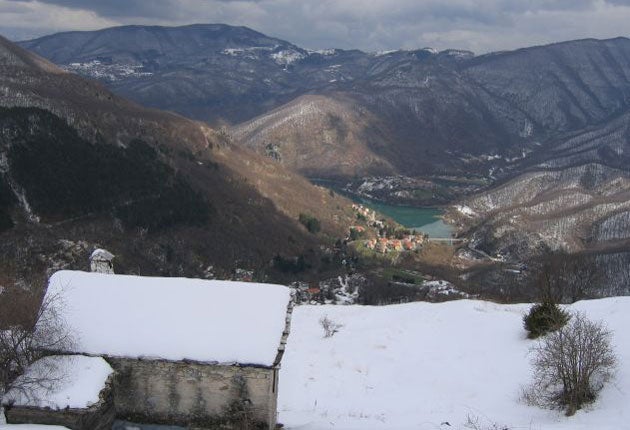Off the beaten track in Tuscany
Tracey Foss straps on her snowshoes to explore the high points of this beautiful region

Mamma had just come into the dining room from the kitchen with a huge saucepan in one hand, a spoon waving around in the other. "Who wants more pasta? There's some left!" She had little English – I had even less Italian – but somehow we managed to communicate.
I had come to Italy in March for a week's gentle walking in the rolling hills of Tuscany and I was hoping to catch the first warmth and sunshine of the spring. My base was Braccicorti, a traditional farmhouse in the Garfagnana region in the north-west.
This part of Tuscany is very different from the stereotypical view of cypress-clad hills striped with vines rippling off into an artistic haze. Braccicorti itself is set on the lower slopes of the Apennines just north of Castelnuovo, the capital of the region, about 90 minutes from Pisa airport. The farmhouse enjoys views across the Serchio River valley to the other range that forms a natural barrier around the Garfagnana, the Marble Mountains of the Alpi Apuane, 15km away.
Even this close to the Mediterranean, the usual neat hillside terraces are replaced with an intense cluster of images: green pasture, chestnut and beech woodlands, undulating ridges, and beyond them, jagged mountains.
Braccicorti is an agriturismo farm, cultivating crops and fruits, which are used in the home-made cooking (complemented by produce from nearby farms). The farm is run by two generations of the Giovanetti family. Each member brings their own interests and skills – from photography, archaeology, history and local traditions to mountain biking and alpine hiking – to make the most of the experience for their guests. And Mamma is the heart and soul of the family and the farm. Her smile, twinkling eyes, natural warmth and wonderful food make a homely atmosphere.
The notes from the company I travelled with had hinted at the unpredictable weather: "Early in the season there may be snow patches and snowshoes may have to be used". If you visit Italy in early spring, come prepared to modify your original plans.
We spent a gentle first day exploring the immediate vicinity, then awoke on day two to a complete transformation: the final snowfall of the winter came to enhance our walking week with the chance to snowshoe at higher altitudes.
North-west of our base was a vast reservoir, Lago di Vagli. Until the Forties this was home to the village of Fabbriche di Careggine. Then it was flooded to create the lake and hydroelectric basin that exists today. Every so often the lake is emptied to carry out maintenance work on the dam, and the ruins of the medieval village reappear for the entire summer for visitors to explore (the most recent apparition was in 1994). Around this beautiful and tranquil lake are the towns of Vagli di Sotto and Vagli di Sopra, from where our day's activities commenced.
A climb to about 1,000m – initially on foot and then by snowshoe – took us to the shepherd's village of Campocatino. En route we had passed through woodland and villages that appeared deserted. To find Campocatino's one café open – as if just for us – was a pleasant surprise. The roaring fire added to the warm welcome of the staff.
This pristine area is set in a glacial basin at the foot of a towering mountain. The only signs of life were stone shepherd's huts (some converted into small holiday homes), and one tiny chapel. The Garfagnana region provided a fine playground for snowshoeing novices as we got to grips with our new foot accessories.
A few days later we climbed to about 1,400m – higher than Britain's tallest mountain – zig-zagging through woodland under blue skies on white snow to a breathtaking viewpoint over the mountain range. With not a breath of air, the silence and stillness added an aura of conspiracy to our day; no-one else was in on this secret.
Then the quiet was shattered by shrieks as we tobogganing down a ski-slope back to our homeward transport.
Aside from the endless kilometres of hiking, skiing and cycling that are available in this area of Tuscany, there is culture on offer too. The nearby city of Lucca is a medieval community surrounded by intact walls, which now form a pedestrian walkway, where markets and cafés provide interesting distractions. At the centre is the Piazza Anfiteatro, a large oval piazza which was originally a Roman ampitheatre. Its perimeter is lined with more cafés, restaurants and souvenir shops.
The identity of Lucca's favourite musical son soon becomes clear: Giacomo Puccini gets a viale, a theatre, a restaurant and a boutique hotel named after him. There's also a statue of the composer, looking casual and confident, with a cigarette in his right hand.
At the end of the week, the whole clan came out to thank us for our visit and blessed us with good Tuscan wishes for our future health and happiness. Both had certainly been enhanced during our stay. Thank you, Mamma.
Traveller's guide
The writer bought a winter-walking package from Exodus (0845 863 9600; exodus.co.uk); 2009 prices start at £799 including flights from Gatwick to Pisa. For independent travellers, Pisa has flights from a wide range of UK airports – andhas its own railway station. You can travel by train, via Pisa Centrale and Lucca to Villetta San Romano, from where a short taxi ride or a 15-minute walk will get you to Braccicorti.
Join our commenting forum
Join thought-provoking conversations, follow other Independent readers and see their replies
Comments
Bookmark popover
Removed from bookmarks